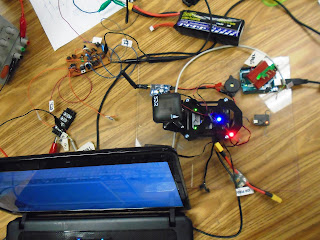AV Work Day
Date:5.31.16Time: 7:30 AM-1:30 PM
Location: Logan HS
Students: Clare, Isaac, Zach, and Oscar
Goal: Test out interfaces and solder all connections together if testing is positive.
A lot of little time consuming work today testing out the interfaces and soldering connections together that were previously mounted and wired with terminal strips. The good news is the tests working on the vehicle and our steering and main drive work. We had a limit switch (or lack there of) problem with our steering mechanism. The linear actuator works well, but when it moves to full extension, it drives our control arm into the frame. We have to adjust that or add limit switches to the design. The actuator is always trying to sense "center point" so we get some back and forth motion with the actuator when the vehicle is going straight.
Students came in on their day off to work on this. We have about 7-8 wires to solder and we should be ready for a test run on the blacktop tomorrow.
 |
| Zach and Oscar working on some connections. |
 |
| Clare and Isaac soldering. |
First test of the main drive interface with the entire system together.
































